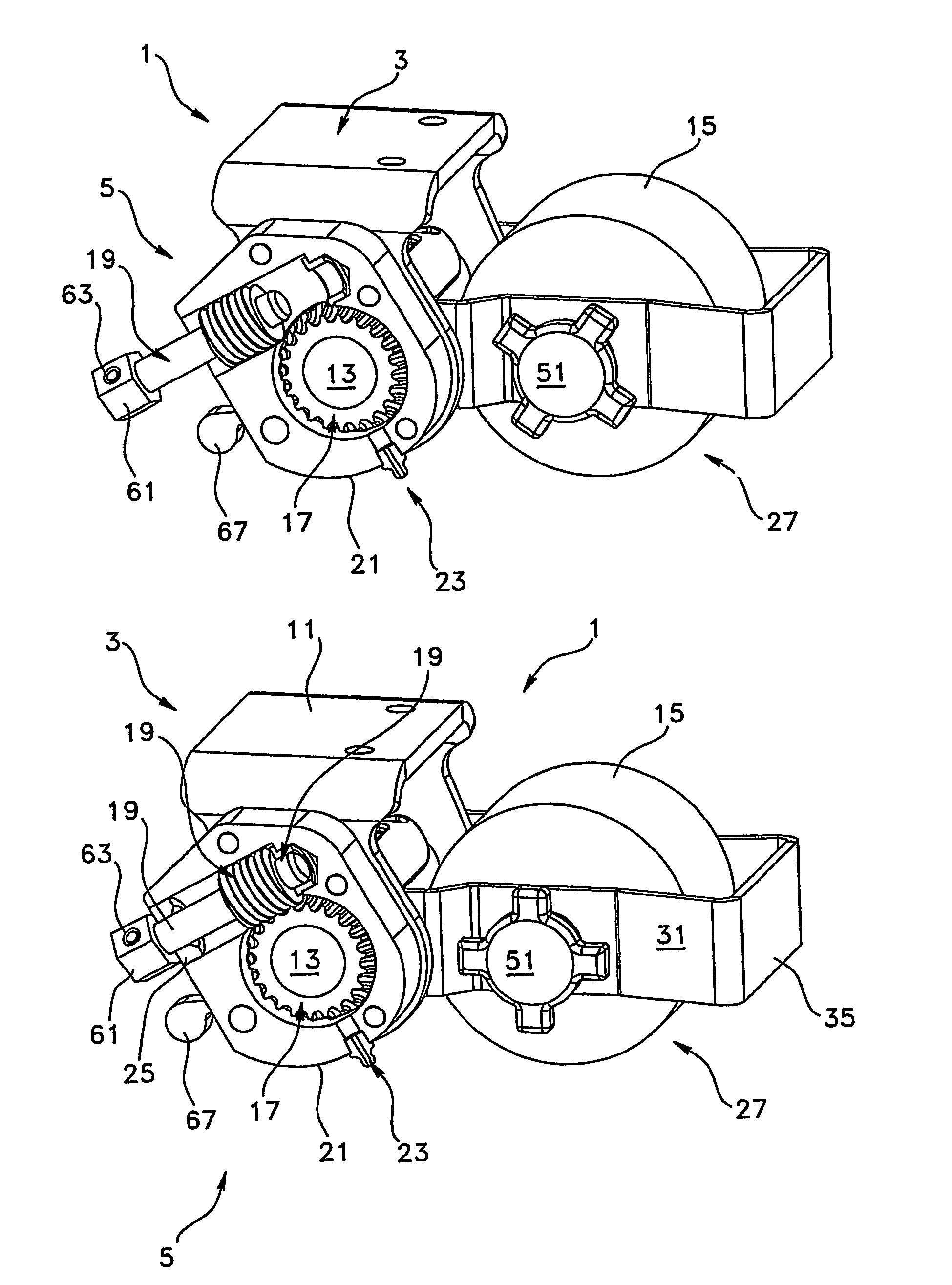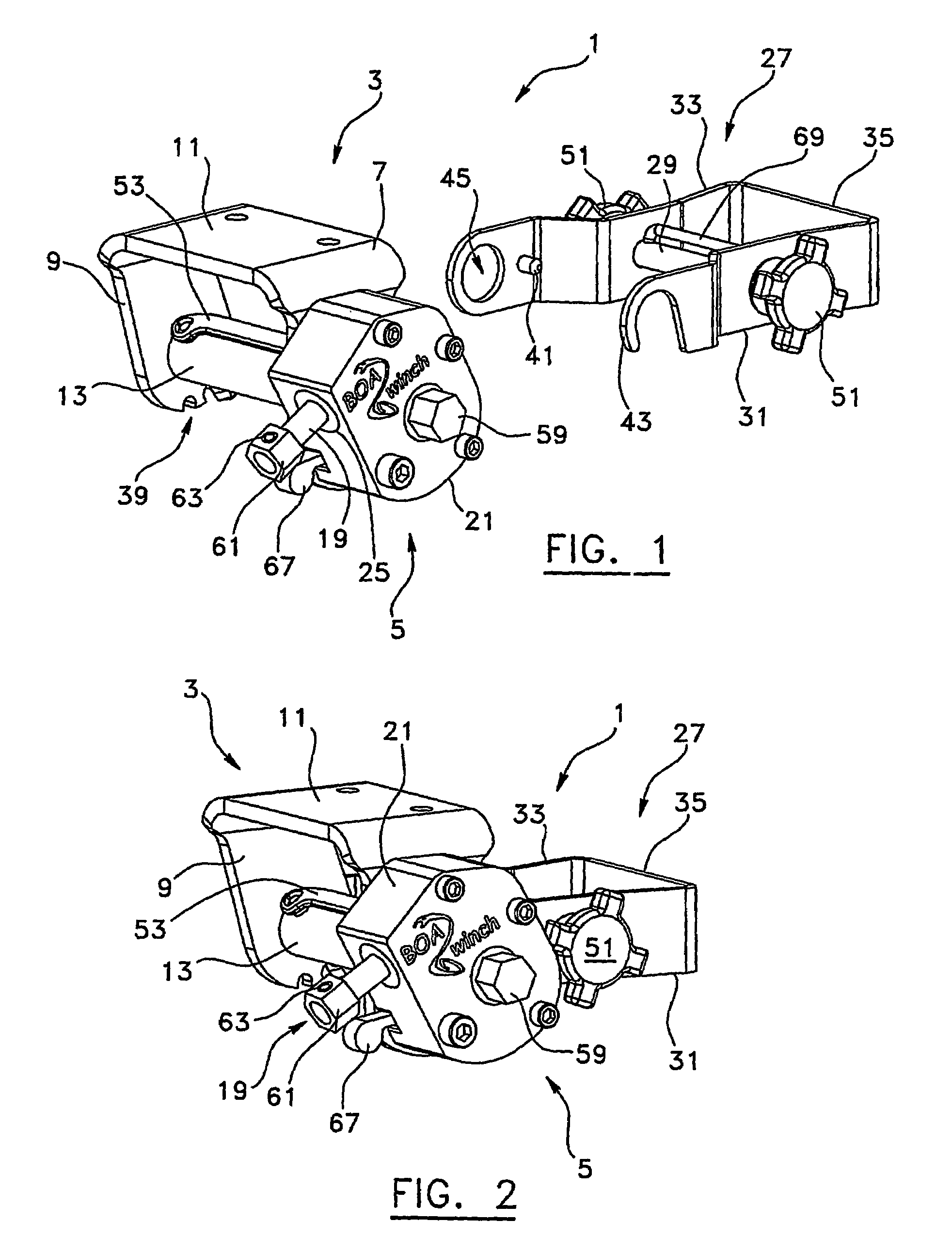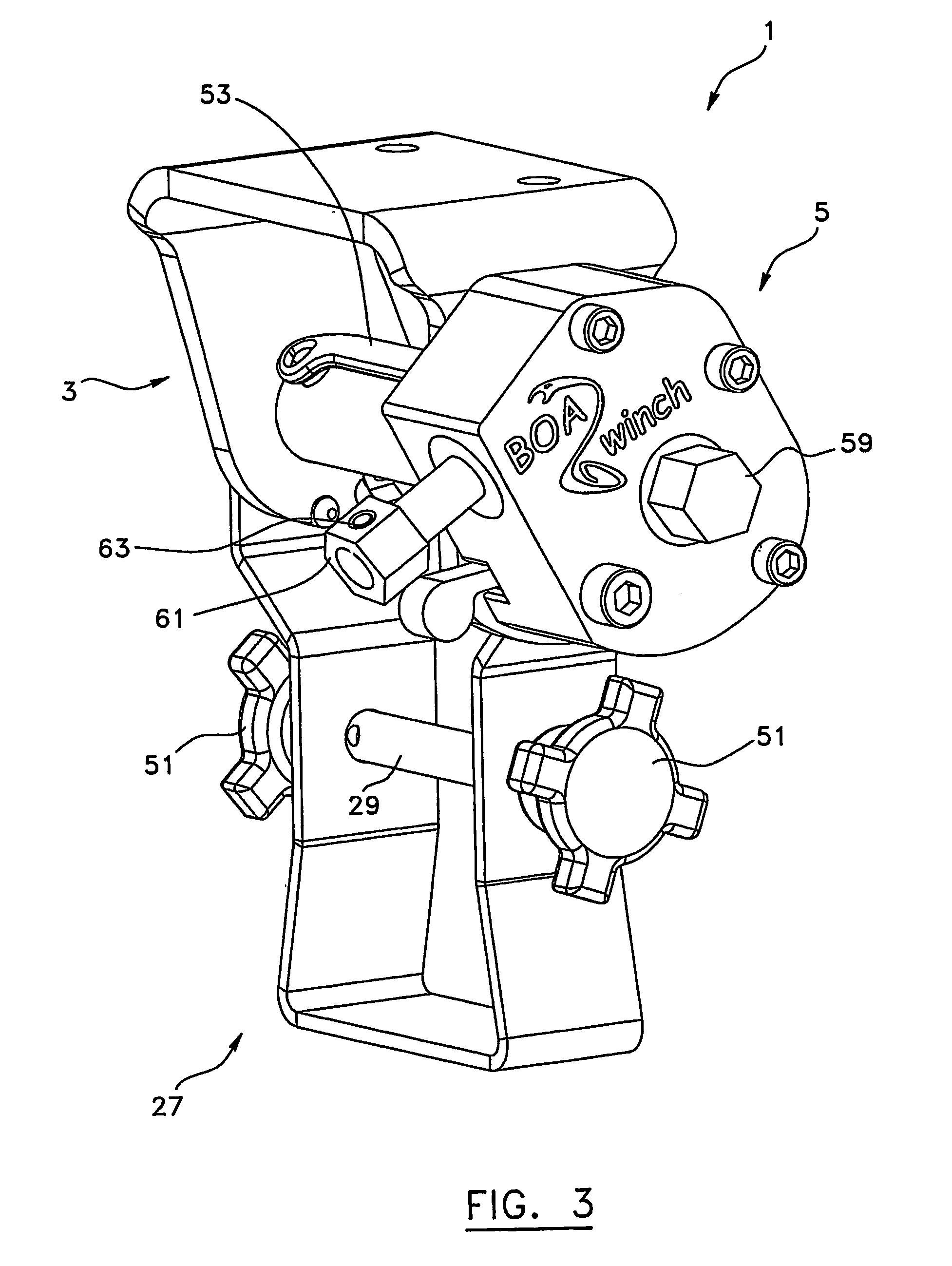Secondly, the belt is then rolled-up onto the winch reel.
A problem associated with this type of tie down winch and method of tightening is that it is impossible to tighten rather securely the winch in position when it is not used.
Indeed, this is explained by the fact that during the tightening, the winch moves in the same direction as the force applied which in turn provokes a premature wear of the trailer rails caused by the vibrations which result when the vehicle circulates.
As can be appreciated, this step is difficult because the use of both hands by an operator is required to manipulate and the bar and the latch at the same time.
It has been found in the art that this method of tightening requires a significant amount of force by the user on the bar and thus has been found to cause wounds, namely stresses and strains on different body parts of an operator of such typical tie down winches.
Furthermore, since the tightening force transmitted to the fastening belt is directly proportional to the force applied by the operator with the bar, it has been found that the physical requirements and resulting fatigue of an operator generally have adverse consequences on the tightening tension applied to the different fastening belts (they are not uniform, not constant, etc.).
Furthermore, it has also been found that since the belt is rolled-up on itself several times, there will be a loss of tension in the belt due to the yielding of the wound portion of the belt and as a result thereof, it is necessary that the transportation vehicle be stopped periodically and that the load be retightened several times during the transportation of the cargo.
It has been found in the art that what often happens is that the link used does not allow an adequate tightening of the chain.
As a result thereof, a proper tightening is very difficult to obtain.
Also known in the art are the various disadvantages associated with the above-described types of conventional winches.
The substantial disadvantages of such tightening method is that it is very demanding physically and can cause serious harms and / or injuries to an operator.
Furthermore, due to the poor design and components of such typical tie down winch and corresponding straps, the tightening is often uneven on all the different winches of a trailer because the level of fatigue of the operator increases from the tightening of a first winch to the tightening of a subsequent winch.
Indeed, it has been found that there are substantial tightening tension discrepancies between the first winch tightened by the operator and the last winch tightened by the operator which in turn causes tightening unbalances along the cargo supported by the vehicle, which is very undesirable for stability reasons, as can be easily understood.
Another substantial
disadvantage associated with conventional winches is that the tightening force thereof is not constant and not uniform.
As aforementioned, very often there is not enough tightening force present in the fastening straps, and / or there are differences in the tightening forces from one strap to another, and this increases the risk of slipping and shifting of the load during transportation, which is very undesirable.
Another
disadvantage associated with conventional winches is that the tension applied to the belt is maintained by means of a latch fixed to the frame of the winch, which blocks the reel.
In the advent of a reversal of the trailer, the pressure will thus be distributed by the latch onto the frame of the winch, and in turn this will tend to deform the winch under the
impact and release the load, which is very undesirable for obvious reasons known in the art.
Another problem associated with conventional winches is that the belt is squeezed on itself around the reel of the winch during the tightening process which is undesirable because the belt presses on itself during the tightening, thereby resulting in a loss of tightening tension.
Moreover, as a result thereof, the tightening is uneven on all the different winches of the trailer which in turn provokes a deformation and a premature wear of the trailer.
Moreover, as a result of the aforementioned, there is a loss of tension in the belts due to the vibrations during the transportation which in turn obliges the operator to frequently stop the vehicle and retighten the belt several times during a given trip.
Moreover, there is a premature wear of the belt resulting when the tightening in the presence of sand, dust and / or other debris between the windings of the belt.
Another problem associated with conventional winches is that the belt must be manually rolled-up on all its length about the reel of the winch before being tightening in place with the winding bar.
This is undesirable because it is a long procedure and very time-consuming; does not allow to fix solidly the winch to the rails of the trailer because the winch moves in the same direction as the tightening force; and causes wear of the trailer rails to which winches are fixed due to the vibrations of the winches when the vehicle circulates.
Indeed, in certain cases, rails must be replaced on a yearly basis, which is very costly.
Another problem associated with conventional winches is that the operator must raise the latch to unblock the reel at the same time as he / she is attempting to loosen the belt by means of the winding bar.
This is very undesirable because it is difficult to operate the winch since the operator must use both hands to operate both the latch and the winding bar at the same time.
Another problem associated with conventional winches and with the chain benders used therewith is that once again, the principle of lever is required to tighten the chains, which in turn results in the same disadvantages associated with conventional winches and their straps.
Indeed, this is very undesirable in that the method is very demanding physically and can cause serious harms and / or injuries to the operator of the winch.
Moreover, an operator is often required to go over the load in order to operate the chain benders, which may in turn result in falls from the load and serious injuries to the operator.
Furthermore, the load is often unsufficiently or excessively tightened because the step of tightening is based on the length of a given
chain link, which in turn causes an improper tightening and damages to the equipment.
 Login to View More
Login to View More 


